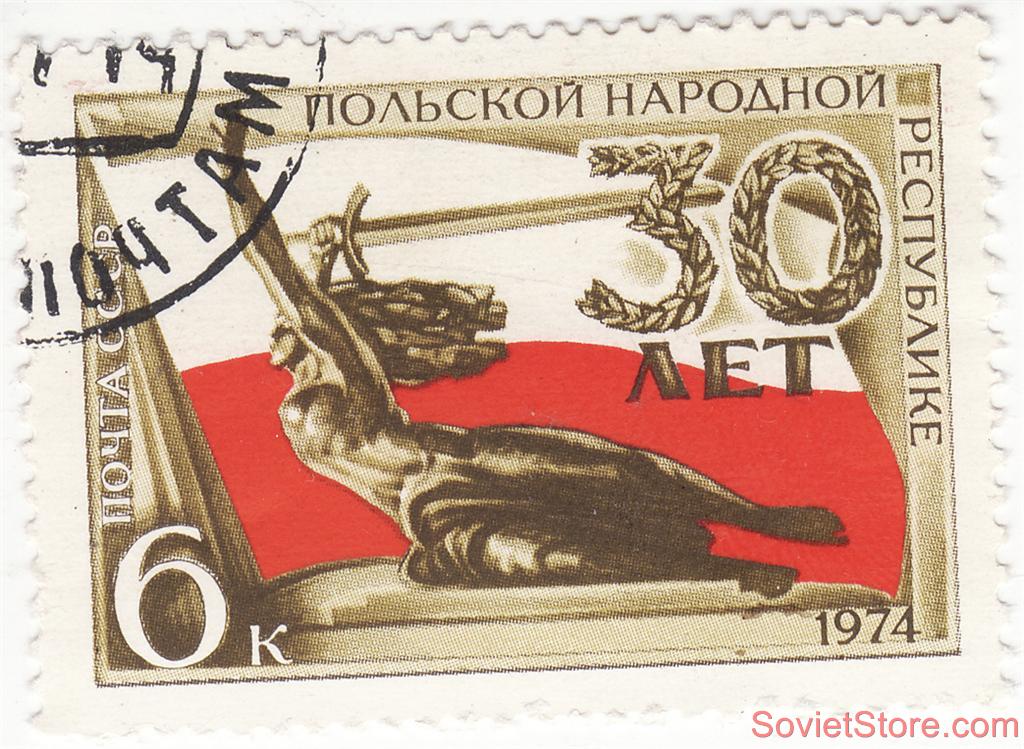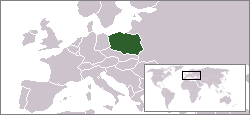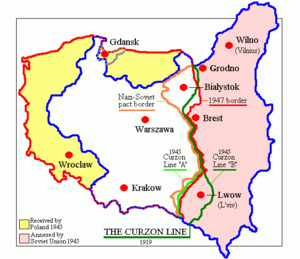SearchProduct Type
|
Add us to: Favorite Stores Item's weight: less then 1 g.
Stamp Authenticity Since 1939 till 1990 Lithuania suffered 3 occupations: 1 German (1941-1944) and 2 Soviet (1939-1941, 1944-1990), one of which lasted 46 years. In WWII occupations were based on violent battles between Germans and Russians. These historical events left a lot of stuff behind them selves. Almost every family in Lithuania has something left, related to USSR history in their forgotten drawers. So we are just traveling around lithuanian countrysides and collecting this memorabilia. Item is original, genuine, authentic, unique, not a copy or replica - has 2-12 decades of it's own unique history.
Marian Konieczny (born January 13, 1930(1930-01-13)) is a Polish sculptor. A 1954 graduate of the Akademia Sztuk Pięknych w Krakowie (Jan Matejko Academy of Fine Arts) in Kraków, Konieczny was a student of Xawery Dunikowski. Konieczny himself was a professor and rector of the Academy from 1972 to 1981. Author of many notable monuments, such as the Warsaw Nike (pl:Warszawska Nike). Recipient of Polonia Restituta in 2000.
The People's Republic of Poland or Polish People's Republic (Polish: Polska Rzeczpospolita Ludowa, PRL; Russian: Польская Народная Республика, ПНР) was the official name of Poland from 1952 to 1989 inclusively. Although the People's Republic of Poland was a sovereign state as defined by international law, its leaders were at the very least approved by Soviet leaders.[citation needed] They aligned their policies with those of Moscow, making the People's Republic of Poland a satellite state almost entirely subordinate to the Soviet Union. The Soviets had much influence over internal affairs and foreign affairs,[citation needed] and Red Army forces were stationed in Poland (1945 - 500,000; until 1955 - 120,000 to 150,000, until 1989 - 60,000 to 80,000).In 1945, Soviet generals and advisors formed 80% of the officer cadre of Wojsko Ludowe, and by 1948, 30 to 40%. The Polish Communist Party soon became the sole legal party, making the PRL an officially communist state. History
At the Yalta Conference in February 1945, Stalin was able to present his western allies, Franklin Roosevelt and Winston Churchill, with a fait accompli in Poland. His armed forces were in occupation of the country, and his agents, the communists, were in control of its administration. The USSR was in the process of incorporating the lands in eastern Poland which it had occupied between 1939 and 1941. In compensation, the USSR awarded Poland all the German territories in Pomerania, Silesia and Brandenburg east of the Oder-Neisse Line, plus the southern half of East Prussia. Stalin was determined that Poland's new government would become his tool towards making a Poland a Soviet puppet state controlled by the communists. He had severed relations with the Polish government-in-exile in London in 1943, but to appease Roosevelt and Churchill he agreed at Yalta that a coalition government would be formed. The communists held a majority of key posts in this new government, and with Soviet support they soon gained almost total control of the country, rigging all elections. Their opponents, led by Stanisław Mikołajczyk, managed only one victory, but it was a substantial one: Poland preserved its status as an independent state, contrary to the plans of some influential communists such as Wanda Wasilewska, who were in favour of Poland becoming another republic of the Soviet Union. This important victory would be their last, however, as the communists, tightening their grip on power, began political persecution of all opposition.[citation needed] Many of their opponents decided to leave the country, and others were put on staged trials and sentenced to many years of imprisonment or execution.
In June 1946 the 3xTAK referendum was held on a number of issues--abolition of the Senate of Poland, land reform, and making the Oder-Neisse line Poland's western border. The communist-controlled Interior Ministry issued results showing that all three questions passed overwhelmingly. Years later, the Communists revealed that the first two questions had passed only by means of massive fraud on their part.[citation needed] Between then and the January 1947 general elections, the opposition was subjected to ruthless persecution, and many opposition candidates were prevented from campaigning. The Polskie Stronnictwo Ludowe (PSL) party in particular suffered harsh persecution; it had opposed the abolition of the Senate as a test of strength against the government. Although it supported the other two questions, the communist-controlled government branded the PSL "traitors". This massive repression was overseen by the leader of the Polish Workers' Party, Władysław Gomułka. He was assisted by the provisional president, Bolesław Bierut, nominally neutral but in fact an old-line Stalinist.[citation needed] However, Gomułka never supported Stalin's control over the Polish communists, and was soon replaced as party leader by the more pliable Bierut. Bierut then took advantage of a split in the Polish Socialist Party. One faction, which included Prime Minister Edward Osóbka-Morawski, wanted to join forces with the Peasant Party and form a united front against the PUWP. Another faction, led by Józef Cyrankiewicz, argued that the Socialists should support the communists in carrying through a socialist program, while opposing the imposition of one-party rule. Pre-war political hostilities continued to influence events, and Mikołajczyk would not agree to form a united front with the Socialists. The communists played on these divisions by dismissing Osóbka-Morawski and making Cyrankiewicz Prime Minister. The elections produced a parliament with 394 seats for the communist-controlled Democratic Bloc and 28 for the PSL. Mikołajczyk immediately resigned from the government in protest of this blatantly fraudulent result. In 1989, the communists admitted that they, in fact, had engaged in massive fraud.[citation needed] In April, facing arrest, he left the country. From this point onward, Poland was a de facto Soviet satellite, though it was not officially transformed into the People's Republic of Poland until the adoption of the 1952 Constitution. In 1948, the communists consolidated their power, merging with Cyrankiewicz' faction of the PPS to form the Polish United Workers' Party (known in Poland as 'the Party'), which would monopolise political power in Poland until 1989. Soviet Marshal Konstantin Rokossovsky became Polish Minister of National Defence, with the additional title Marshal of Poland, and in 1952 he became Deputy Chairman of the Council of Ministers. Over the coming years, private industry was nationalised, the land seized from the pre-war landowners and redistributed to the peasants, and millions of Poles were transferred from the lost eastern territories to the lands acquired from Germany. Poland was now to be brought into line with the Soviet model of a "people's democracy" and a centrally-planned socialist economy. The government also embarked on the collectivisation of agriculture, although the pace was slower than in other satellites: Poland remained the only Soviet bloc country where individual peasants dominated agriculture. Despite the fact that Polish historians estimate that 200,000 to 400,000 people died during the postwar period,[citation needed] . In June 1956, workers in the industrial city of Poznań (Posen) went on strike. Voices began to be raised in the Party and among the intellectuals calling for wider reforms of the Stalinist system. Eventually, power shifted towards Gomułka, who replaced Bierut as party leader. Hardline Stalinists were removed from power and many Soviet officers serving in the Polish Army were dismissed. This marked the end of the 'Stalin Poland'. However, by the mid 1960s Poland was starting to experience economic as well as political difficulties. Gomułka's reformist veil soon fell off. The next stage of Polish history began in December 1970. Gomułka's government had decided to prop up the failing economy by suddenly announcing massive increases in the prices of basic foodstuffs. The resulting wide-spread protests led to another major change in the government, as Gomułka was replaced by Edward Gierek as the new First Secretary. Gierek's plan for recovery was centered on massive borrowing, mainly from the United States and West Germany, to re-equip and modernise Polish industry, and to import consumer goods to give the workers some incentive to work. While it boosted the Polish economy, and is still remembered as the "Golden Age" of communist Poland, the obvious repercussion in the form of massive debt is still felt in Poland even today. This Golden Age came to an end after the 1973 energy crisis. The failure of the Gierek government, both economically and politically, soon led to the creation of opposition in the form of trade unions, student groups, clandestine newspapers and publishers, imported books and newspapers, and even a "flying university." At this juncture, on 16 October 1978, Poland experienced what many Poles believed to be literally a miracle. The Archbishop of Kraków, Cardinal Karol Wojtyła, was elected Pope, taking the name John Paul II. The election of a Polish Pope had an electrifying effect on what was notably one of the most devoutly Catholic nations in Europe. When John Paul toured Poland in June 1979, half a million people heard him speak in Warsaw, and about a quarter of the entire population of the country attended at least one of his outdoor masses.[citation needed] Overnight, John Paul became the de facto leader of Poland,[citation needed] leaving the government not so much opposed as ignored. John Paul did not call for rebellion, instead he encouraged the creation of an "alternative Poland" of social institutions independent of the government, so that when the next crisis came, the nation would present a united front. A new wave of strikes undermined Gierek's government, and in September Gierek, who was in poor health, was finally removed from office and replaced as Party leader by Stanisław Kania. However Kania was unable to find an answer for the fast-eroding support of communism in Poland. Labour turmoil led to the formation of the independent trade union Solidarity (Polish Solidarność) in September 1980, originally led by Lech Wałęsa. In fact Solidarity became a broad anti-communist social movement ranging from people associated with the Roman Catholic Church, to members of the anti-communist left. By the end of 1981, Solidarity had nine million members, a quarter of Poland's population and three times as many as the PUWP had. On December 13, 1981, the government leader, Wojciech Jaruzelski, who had become the party's national secretary and prime minister that year, became supposedly fearful of Soviet intervention (real fearful was few months earlier) and started a crack-down on Solidarity. He declared martial law in Poland, suspended the union, and temporarily imprisoned most of its leaders. The government then banned Solidarity on October 8, 1982. Martial law was formally lifted in July 1983, though many heightened controls on civil liberties and political life, as well as food rationing, remained in place through the mid- to late-1980s. This did not prevent Solidarity from gaining more support and power. Eventually it eroded the dominance of the PUWP, which in 1981 lost ca. 85,000 of its 3 million members. Throughout the mid-1980s, Solidarity persisted solely as an underground organization, but by the late 1980s was sufficiently strong to frustrate Jaruzelski's attempts at reform, and nationwide strikes in 1988 were one of the factors that forced the government to open a dialogue with Solidarity. From February 6 to April 15, talks of 13 working groups in 94 sessions, which became known as the "Roundtable Talks" (Polish: Rozmowy Okrągłego Stołu) radically altered the shape of the Polish government and society. The semi-free June elections brought a victory for the Solidarity movement that took all contested (35%) seats in the Sejm, the Parliament's lower house, and 99% seats in the fully-free elected Senat. In August a Solidarity-led coalition government took power with Tadeusz Mazowiecki as Prime Minister. On December 29 the Parliament changed the Constitution restoring democracy and political freedoms. This began the Third Polish Republic and effectively ended the Communist Party's hold on the government. Government and politicsThe government and politics of the People's Republic of Poland were dominated by the Polish United Workers' Party (Polska Zjednoczona Partia Robotnicza, PZPR). In effect, Poland was a single-party state following a communist ideology, dependent on the USSR to the extent of being its satellite state. Since 1952 the PRP highest law was the Constitution of the People's Republic of Poland. Polish Council of State replaced the president of Poland. Economy
|
|||||||||||||||||||||||||||||||||||||||||||||||||||||||||||||||||||||||||||||||||||||||||||||||||||||||||||||||
References
- ^ Neier, Aryeh (2003). Taking Liberties: Four Decades in the Struggle for Rights. Public Affairs, p. 251. ISBN 1891620827.
- ^ Jackson, John E; Jacek Klich, Krystyna Poznanska (2005). The Political Economy of Poland's Transition: New Firms and Reform Governments. Cambridge University Press, p. 21. ISBN 0521838959.
- (1995) PRL dla początkujących. Wrocław: Wydawnictwo Dolnośląskie, 348. ISBN 83-7023-461-5.
The free listing tool. List your items fast and easy and manage your active items.
On Jul-06-08 at 11:44:25 PDT, seller added the following information:
Refund will be given as Money back.
Refund policy details:
Return is accepted at any reason. Item(s) must arrive to us not later then 30 days after it was shipped out (you will be informed about this immediately after it will be done). Returned items must be the same item in the exact same condition as originally shipped. Refunds are for the final eBay item purchase price only, less a 10% restocking fee. Shipping costs, insurance, and handling charges (if any) are non refundable. Returns must be shipped insured.
Destination: Lithuania | |||
|---|---|---|---|
| Carrier | Method | Shipping Cost | Per additional Item |
| STANDARD | Standard | $1.50 | |
Destination: Worldwide | |||
| Carrier | Method | Shipping Cost | Per additional Item |
| STANDARD | Standard | $1.50 | |
Type | Instructions to Buyer |
|---|---|
| Paypal | null |















